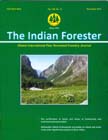Forest-fringe Communities, JFPM and REDD+ in India
DOI:
https://doi.org/10.36808/if/2012/v138i11/28658Keywords:
Communities, Deforestation, Forest Degradation, Joint Forest Management, REDDAbstract
Forest-fringe communities usually depend on forest to meet their day-to-day sustenance and biomass needs. More than a third of notified forests in India are being managed under joint forest planning and management (JFPM) programme involving forest-fringe communities and state forest departments. These jointly managed forests have degraded due to over-use in the past. At present the focus of management in such jointly managed forests is on their rejuvenation and rationalized use. By implication, in the long term JFPM is carbon positive approach, and biodiversity conservation and livelihoods strengthening are its byproducts. REDD+ (Reducing Emissions from Deforestation and forest Degradation plus) envisions the same with added incentives from tradable carbon units that would improve the flow of revenue benefits for forest-fringe communities. Under the emerging REDD+ scenario, JFPM is likely to provide a ready foundation to initiate REDD+ that is likely to enhance the resilience of forests as well as communities in face of climate change. Forest management under REDD+ regime is not likely to be much different from that under JFPM at the ground level however its administration is expected to involve several anticipated issues and other completely new issues. The present study looks at the present forest management regime under JFPM to assess the opportunity for forest-fringe communities to participate in REDD+ programme.Downloads
Download data is not yet available.
Downloads
Published
2012-11-01
How to Cite
Sharma, J., & Singh, M. P. (2012). Forest-fringe Communities, JFPM and REDD+ in India. Indian Forester, 138(11), 991–998. https://doi.org/10.36808/if/2012/v138i11/28658
Issue
Section
Articles
License
Unless otherwise stated, copyright or similar rights in all materials presented on the site, including graphical images, are owned by Indian Forester.





